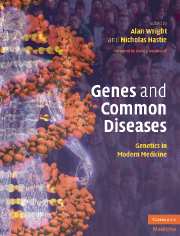Book contents
- Frontmatter
- Contents
- List of Contributors
- Foreword
- Section 1 Introductory Principles
- 1 Genes and their expression
- 2 Epigenetic modification of chromatin
- 3 Population genetics and disease
- 4 Mapping common disease genes
- 5 Population diversity, genomes and disease
- 6 Study design in mapping complex disease traits
- 7 Diseases of protein misfolding
- 8 Aging and disease
- 9 The MHC paradigm: genetic variation and complex disease
- 10 Lessons from single gene disorders
- 11 Environment and disease
- 12 Contemporary ethico-legal issues in genetics
- Section 2 Common Medical Disorders
- Index
- References
5 - Population diversity, genomes and disease
Published online by Cambridge University Press: 17 August 2009
- Frontmatter
- Contents
- List of Contributors
- Foreword
- Section 1 Introductory Principles
- 1 Genes and their expression
- 2 Epigenetic modification of chromatin
- 3 Population genetics and disease
- 4 Mapping common disease genes
- 5 Population diversity, genomes and disease
- 6 Study design in mapping complex disease traits
- 7 Diseases of protein misfolding
- 8 Aging and disease
- 9 The MHC paradigm: genetic variation and complex disease
- 10 Lessons from single gene disorders
- 11 Environment and disease
- 12 Contemporary ethico-legal issues in genetics
- Section 2 Common Medical Disorders
- Index
- References
Summary
Introduction
The striking success in mapping Mendelian disease genes, coupled with the rapid development of genomic methodologies have generated an initial wave of enthusiasm that progress in understanding the genetics of common diseases might experience similar success. Over the past five years however, this optimism has diminished sharply as the difficulty of the task has become apparent. This difficulty is highlighted by the fact that, to date, very few genes have convincingly been shown to harbor variants that influence predisposition to a common disease (Glazier et al., 2002; Lohmueller et al., 2003).
However, recent progress has been relatively rapid in a number of relevant methodologies for genetic association studies. In particular, there has been considerable progress in making use of linkage disequilibrium (LD) to more efficiently and comprehensively represent human genetic variation in association studies. There now appears reason to be cautiously optimistic that the field may begin to progress more rapidly.
This chapter focuses primarily on factors influencing patterns of human genetic variation, and the implications of the patterns of variation in medical genetics. A central theme is the role of the HapMap project in facilitating genetic association studies. We consider both the use of the HapMap to identify single nucleotide polymorphisms (SNPs) that efficiently represent other SNPs (that is, tagging SNPs), and also the use of the HapMap data to help optimise methods for identifying the causal variants that underlie genotype–phenotype correlations.
- Type
- Chapter
- Information
- Genes and Common DiseasesGenetics in Modern Medicine, pp. 80 - 91Publisher: Cambridge University PressPrint publication year: 2007



